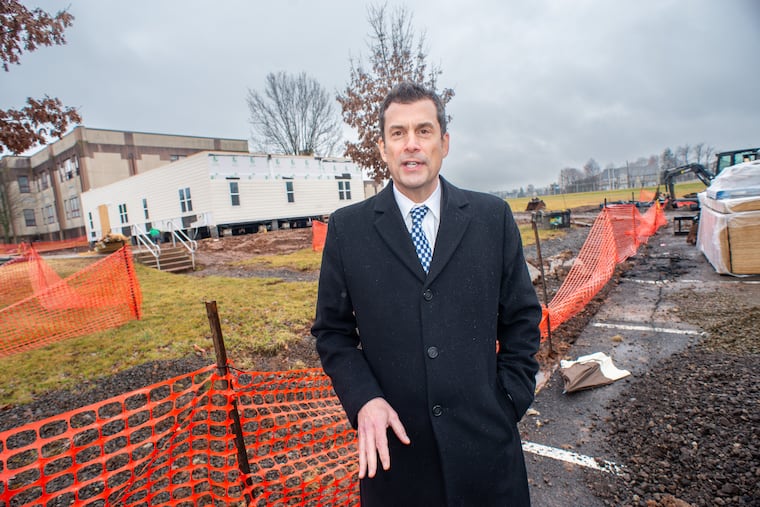The North Penn School District is launching a health center to save money and attract teachers. Others may follow.
As school systems look for ways to stem rising costs — and compete for a waning supply of new teachers — observers predict more will consider the on-site centers.

Rather than take a day off for a doctor’s appointment, teachers in the North Penn School District will soon be able to visit a district-created health center near one of its schools — with no copays and with prescriptions on hand.
It’s a new initiative the Montgomery County district is hoping will help curb health-care costs, in part by reducing pricey urgent care claims and increasing preventative care.
But the center, slated to open next month, is also intended as a recruitment tool at a time when schools are desperate to hire and retain staff.
“We can’t always open the floodgates of the bank and say, ‘We’re going to do all this,’” said Sean Devlin, the president of the district’s teachers’ union. But “what else can we do ... to make North Penn just a little bit more appealing than the next district around?”
Employee health centers aren’t common in Pennsylvania school districts. But as school systems look for ways to stem rising costs — and compete for a waning supply of new teachers — observers predict more will consider contracting with outside providers for on-site centers, which are offered by a variety of private-sector and some government employers.
North Penn officials got the idea from the Lancaster-Lebanon Intermediate Unit — an agency that offers services to schools in the two counties — which says it’s held health costs flat since opening centers for its 1,600 employees eight years ago. Two York County school districts have or are opening health centers, while in the Philadelphia region, the Central Bucks School District last year gave teachers and administrators the option of choosing a new Doylestown-based health center for district employees as their primary-care provider.
“Why is the school district getting into the health-care business? My response is, we’re already in the health-care business,” said Steve Skrocki, chief financial officer in the North Penn district, which employs about 1,700 teachers and staff and spends about $30 million of its $300 million annual budget on health care.
Seeking ways to contain those costs without cutting benefits, Skrocki was intrigued when he learned what Lancaster-Lebanon was doing — launching North Penn on a process that began five years ago, with visits to school and corporate health centers and several financial studies. Based on an analysis by Trion/Marsh McLennan, a health-care consultant, North Penn anticipates saving $10 million over 10 years by opening the center.
“It’s a win-win for everyone,” said Skrocki, who said he has been hearing from other districts interested in the concept.
The promise of savings, however, is predicated on enough employees using the center. The district, which spent $1.25 million building it, will pay $40,000 a month to Everside Health, a Denver-based company that will employ a physician assistant and nurse to staff it. If employees visit the center instead of an outside primary-care doctor or urgent care, it spares the district from paying insurance claims for those services, Skrocki said. (Employee health-care plans aren’t changing, and a teacher could still have a primary-care doctor but visit the center on occasion, Skrocki said.)
The district aims to get 25% of employees using the center within the first year, and 45% after four or five years, Skrocki said.
Skrocki has made presentations to employees, while Devlin, the local teachers’ union president, said he’s working with Everside to promote the center — near Penndale Middle School, a central location within the district — to members.
Devlin said he’s also pushing for more services going forward, like virtual mental-health options.
Depending on how the center’s services are used, there’s room for expansion, possibly including areas like physical therapy, Skrocki said.
He points to the experience of Lancaster-Lebanon, where the intermediate unit’s chief operating officer, Flip Steinour, says his health-care costs remain around $10 million, the same as when the unit opened its first centers in 2015. Based on annual inflation in health-care costs, that bill would likely be around $16 million today without the new model, Steinour said.
At first, employees worried that the intermediate unit would have access to their personal medical information — which isn’t true, Steinour said. The second hurdle was convincing people they didn’t have to switch primary-care doctors.
But staff started using the center once they realized how readily available appointments were — leading to more preventative care, Steinour said. “We were able to get some of those naysayers,” he said, adding that employees are also filling prescriptions they may have skipped in the past, because they no longer have copays.
The intermediate unit has also used its centers as a recruitment tool, allowing part-time staff — who don’t get health-care benefits — free access, Steinour said.
With substitute teachers in short supply, North Penn also hopes its center will serve as an incentive: Substitutes who work for at least 25 days in the district will be able to use it for free, Skrocki said.
The center might also help ease the substitute crunch by reducing the number of times teachers have to take off a full day to visit a doctor, instead making an appointment at the center, said Tina Stoll, North Penn’s school board president.
As district costs have been rising faster than state aid, so much of school budgets are tied up in salaries and benefits that “there’s not a lot of wiggle room for things,” Stoll said. “You really have to be very creative in your thinking of how you can save money.”